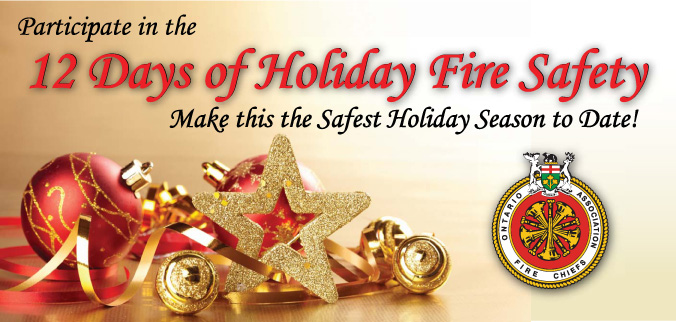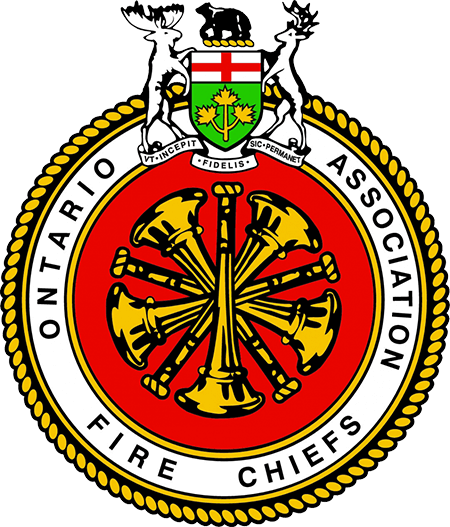Winter Holiday Safety

Participate in the 12 Days of Holiday Fire Safety and Follow the Important Safety Tips below
to ensure a Safe and Happy Holiday Season!
While the holidays are widely considered to be the most wonderful time of the year, they can also be among the deadliest.
Together, the Office of the Fire Marshal (OFM) along with the Fire Marshal’s Public Fire Safety Council (FMPSFC), Ontario Association of Fire Chiefs (OAFC), Ontario Municipal Fire Prevention Officers’ Association (OMFPOA) and Ontario Association of Fire Educators (OAFE) is reminding Ontarians of the importance of fire safety this holiday season with a 12-day awareness campaign.
In December 2024, the OAFC will be sharing advice and recommendations to avoid behaviours that are often contributing factors to the fatal fires that are seen during this time of the year.
You can follow along on our social media platforms for tips on the following fire safety concerns:
Holiday Fire Safety
- Tweet/post links to the holiday safety infographic and social media cards (French)
- Consider using the radio PSA scripts (French) to make videos on your cell phone then post the videos on your social medial channels. You can also send the scripts to your local radio station and ask that they be recorded for use on air
- Tweet/post links to ESA’s holiday fire safety information
Stay tuned to the OFM's Twitter page (French) for even more Holiday Fire Safety resources in the coming weeks!
For more information on the Ontario Fire Marshal and Emergency Management's Initiative on the "12 Days of Holiday Fire Safety" visit their SharePoint.
If you are experiencing difficulties accessing the resource links within this communication, please register for the new SharePoint site.
Check in with our social media during the 12 Days of Holiday Fire Safety.
Christmas Trees
When purchasing an artificial tree, look for the label "Fire Resistant." Although this label does not mean the tree won't catch fire, it does indicate the tree will resist burning and should extinguish quickly.
When purchasing a live tree, check for freshness. A fresh tree is green; needles are hard to pull from branches and when bent between your fingers, needles do not break. The trunk butt of a fresh tree is sticky with resin, and when tapped on the ground, the tree should not lose many needles.
When setting up a tree at home, place it away from fireplaces and radiators. Because heated rooms dry live trees out rapidly, be sure to keep the stand filled with water. Place the tree out of the way of foot traffic and do not block doorways.
When you’re ready to get rid of your tree, please do not burn it in the fireplace or wood stove. The rapid burning and excessive heat can damage the firebox and chimney creating a serious fire hazard. Instead, find out from your municipality the day when trees will be picked at your curbside. Many municipalities recycle Christmas trees into mulch.
Lights and Electrical
- Indoors or outside, always use CSA-approved lights. Check each set of lights, new or old, for broken or cracked sockets, frayed or bare wires, or loose connections, and throw out damaged sets.
- Use no more than three standard-size sets of lights per single extension cord.
- Never use electric lights on a metallic tree. The tree can become charged with electricity from faulty lights, and a person touching a branch could be electrocuted.
- Fasten outdoor lights securely to trees, house walls or other firm supports to protect the lights from wind damage. Use only insulated staples, not nails or tacks, to hold strings in place. Or, run strings of lights through hooks (available at hardware stores).
- Turn off all lights when you go to bed or leave the house. The lights could short out and start a fire.
- For added electric-shock protection, plug outdoor electric lights and decorations into circuits protected by ground fault circuit interrupters (GFCIs). Portable outdoor GFCIs can be purchased where electrical supplies are sold. GFCIs can be installed permanently to household circuits by a qualified electrician.
Decorations
- Use only non-combustible or flame-resistant materials to trim a tree. Choose tinsel or artificial icicles of plastic or non-leaded metals. Leaded materials are hazardous if ingested by children.
- Never use lighted candles on a tree or near other evergreens. Always use non-flammable holders, and place candles where they will not be knocked down.
- In homes with small children, take special care to avoid decorations that are sharp or breakable, keep trimmings with small removable parts out of the reach of children to avoid the child swallowing or inhaling small pieces, and avoid trimmings that resemble candy or food that may tempt a child to eat them.
- Wear gloves to avoid eye and skin irritation while decorating with spun glass "angel hair." Follow container directions carefully to avoid lung irritation while decorating with artificial snow sprays.
Holiday Entertaining
- Test your smoke alarms and tell guests about your home fire escape plan. Ensure they are aware of all exits in your home.
- Keep children and pets away from lit candles.
- Keep matches and lighters up high in a locked cabinet.
- Stay in the kitchen when cooking.
- Ask smokers to smoke outside. Remind smokers to keep their smoking materials with them so young children do not touch them. Provide large, deep ashtrays for smokers. Wet cigarette butts with water before discarding.
- Don't drink and drive, or let your guests drink and drive. Make sure you plan ahead and have a designated driver, arrange for a cab or other alternative transportation.
Fireplaces
- Do not remove fireplace embers or ash, or if you do, place them in a metal container with a lid and cover them with water. Do not place them in a plastic or paper bag or other container that is not fire-resistant. Do not dispose of them indoors or close to your home or another structure.
- Use care with "fire salts," which produce colored flames when thrown on wood fires. They contain heavy metals that can cause intense gastrointestinal irritation and vomiting if eaten. Keep away from children.
- Do not burn wrapping papers in the fireplace. A flash fire may result as wrappings ignite suddenly and burn intensely.
- Never burn gift wrappings, boxes, cartons, or other types of packing in the fireplace. They burn too rapidly and generate far too much heat.
- Don't hang Christmas stockings from the mantel when the fireplace is in use.
- Always use a screen in front of the fireplace to protect against flying sparks.
- Never use gasoline or any other flammable liquids to start a fire.
- Use only seasoned and dried wood.
- Never leave the fire unattended or let it smolder.
- Clean the ashes regularly. Place the ashes in a metal container and store outside away from flammable materials.
- Don't use Christmas trees for firewood.
Candles
- Extinguish candles when leaving the room or going to sleep. Keep lit candles away from items that can catch fire
- Place candles in sturdy, burn-resistant containers that won’t tip over and are big enough to collect dripping wax.
- Don’t place lit candles near windows, where blinds or curtains may close or blow over them.
- Don’t use candles in high traffic areas where children or pets could knock them over.
- Never let candles burn out completely. Extinguish them when they get to within two inches of the holder or decorative material.
- Never leave children or pets alone in a room with lit candles.
- Do not allow older children to light candles in their bedrooms. A forgotten candle or an accident is all it takes to start a fire.
- During power outages, exercise caution when using candles as a light source. Many destructive fires start when potential fire hazards go unnoticed in the dark.
- Never use a candle for light when fueling equipment such as a camp fuel heater or lantern.
- Keep candle wicks short at all times. Trim the wick to one-quarter inch (6.4 mm).
- Be wary of buying novelty candles. Avoid candles surrounded by flammable paint, paper, dried flowers, or breakable/meltable containers.
- Extinguish taper and pillar candles when they burn to within two inches of the holder, and container candles before the last half-inch of wax begins to melt.
- When buying or using novelty candles, try to determine if they pose a potential fire hazard (if they contain a combustible component for instance). If they do, or if you suspect that they might, inform your local fire department.
- Use extreme caution when carrying a lit candle, holding it well away from your clothes and any combustibles that may be along your path.
Heating
- Keep anything that can burn at least three-feet away from heating equipment, like the furnace, fireplace, wood stove, or portable space heater.
- Have a three-foot “kid-free zone” around open fires and space heaters.
- Never use your oven to heat your home.
- Have a qualified professional install stationary space heating equipment, water heaters or central heating equipment according to the local codes and manufacturer’s instructions.
- Have heating equipment and chimneys cleaned and inspected every year by a qualified professional.
- Remember to turn portable heaters off when leaving the room or going to bed.
- Always use the right kind of fuel, specified by the manufacturer, for fuel burning space heaters.
- Be sure all furnace controls and emergency shutoffs are in proper working condition.
- Leave furnace repairs to qualified specialists. Do not attempt repairs yourself unless you are qualified.
- Inspect the walls and ceiling near the furnace and along the chimney line. If the wall is hot or discoloured, additional pipe insulation or clearance may be required.
- Check the flue pipe and pipe seams. Are they well supported, free of holes and cracks? Soot along or around seams may be an indicator of a leak.
- Is the chimney solid, with cracks or loose bricks? All unused flue openings should be sealed with solid masonry.
- Keep trash and other combustibles away from the heating system.
In The Kitchen
- Be on alert! If you are sleepy or have consumed alcohol don’t use the stove or stovetop.
- Stay in the kitchen while you are frying, grilling, or broiling food. If you leave the kitchen for even a short period of time, turn off the stove.
- If you are simmering, baking, roasting, or boiling food, check it regularly, remain in the home while food is cooking, and use a timer to remind you that you are cooking.
- Keep anything that can catch fire — oven mitts, wooden utensils, food packaging, towels or curtains — away from your stovetop.
- Have a “kid-free zone” of at least 3 feet around the stove and areas where hot food or drink is prepared or carried.
Grease and fat fires are a leading cause of home fires in Canada, so be extra careful when doing this kind of cooking. Here's what to do if grease in a pot or pan catches fire:
- Smother the flames by covering the pan with a lid. Do not remove the lid until the pan is completely cooled.
- Turn off the heat immediately.
- Use baking soda (flour can be explosive) on shallow grease fires.
- Never turn on the overhead fan, as this could spread the fire.
- Never throw water on a grease fire.
This information is provided by the members of the Ontario Association of Fire Chiefs, the Ontario fire service, the Fire Prevention and Public Education committee and the Office of the Fire Marshal. Questions regarding fire education and prevention should be directed to your local fire department.
